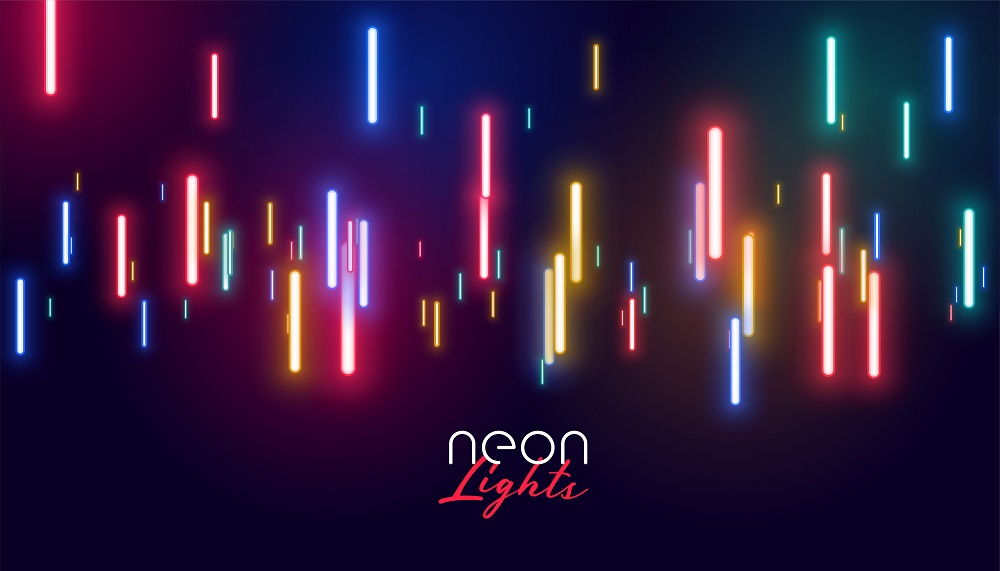
03 May How Do Neon Lights Work
Neon lights have fascinated us for years, shining brightly along urban streets and adding character to countless businesses. But beyond their captivating exterior, there’s a captivating blend of science and engineering at work. Have you ever wondered, “How do neon lights work?”
Let’s discover the science behind these captivating creations.
What are Neon Signs?
Before we discover how neon lights work? Let’s first understand the fundamentals of neon signs.
Neon lights derive their name from the colorless and odorless noble gas neon, which is rarely present in the Earth’s atmosphere. Traditional neon lights contain small amounts of neon gas and emit a reddish-orange glow. Moreover, manufacturers include different chemicals and gasses to achieve that spectrum of colors.
Neon lights consist of glass tubes that can be shaped artistically to form letters or images. They are commonly used in creating vibrant and eye-catching advertisements, known as neon signs.
How Does Neon Light Work
Let’s understand how neon lights work:
- Neon signs consist of glass tubes meticulously shaped into specific designs, each equipped with electrodes positioned at both ends—one serving as the negative terminal, the other as the positive terminal.
- Within these glass tubes, there’s a small quantity of neon gas. This gas, classified as a noble gas, generally remains inert unless subjected to conditions of high energy, such as those induced by electricity.
- Upon the application of an alternating current to the electrodes, the neon atoms contained within the tube become energized, leading to their separation.
- As this process unfolds, some of the neon atoms shed electrons, transforming into positively charged ions that gravitate towards the negative electrode, while simultaneously, free electrons migrate towards the positive electrode.
- Collisions between these charged particles occur within the confines of the glass tube, offering an exchange of energy among the neon atoms, ions, and electrons, thereby elevating their energy levels.
- Eventually, when the ionized atoms reacquire their lost electrons and return to a neutral state, they release photons, which results in a vibrant colored glow. This emission of light is the characteristic of neon signs.
- If the electrical supply to the sign is cut off, the neon atoms return to their inert state, and the glowing display stops until power is restored.
How Do Neon Lights Produce Different Colors?
Neon signs traditionally emit a reddish-orange glow due to the use of neon gas. However, different gasses are utilized to achieve a spectrum of colors, each reacting uniquely to electricity. Alternatively, methods such as phosphor coatings or tinted glass can also modify the emitted light.
In contrast, LED neon signs offer color-changing capabilities through RGB LED or digital LED technology, providing a wide range of color options and intricate patterns.
Dimming traditional neon signs requires specific equipment. LED neon signs offer versatile dimming options to cater to varying lighting needs.
Color Spectrum of Neon Lights
| Gas Type | Color of Light |
| Neon | Red or orange-red |
| Argon | Blue or lavender |
| Helium | Orange or yellow |
| Krypton | Gray or green |
| Xenon | Blue or gray |
| Radon | Purple |
| Mercury | Blue |
| Hydrogen | Red |
Create Your Vision with Vida Signs!
At Vida Signs, we craft captivating neon signs that leave a lasting impression. From dynamic channel letter designs to eye-catching storefront displays, our expert team is dedicated to bringing your vision to life. Illuminate your brand with our vibrant neon creations and stand out from the crowd with Vida Signs.
Contact us today at (212)-388-9388, and let’s bring your vision to life!
FAQs
Why are neon lights so expensive?
The high cost of traditional neon signs is mainly due to their rarity, as crafting them requires specialized skills, resulting in a price that reflects their scarcity and craftsmanship.
How do neon lights produce visible light?
A neon light emits visible light through electroluminescence, where neon or another gas produces light when an electric current flows through it.
Do neon signs use a lot of electricity?
Neon signs are a cost-effective and safer option suitable for both homes and businesses. On average, neon lights consume 400 watts of power, making them more energy-efficient than fluorescent lights, which consume 610 watts, and LED lights, which consume 150 watts.
Which is better: neon or LED?
Neon and LED signs each have their advantages. LED signs excel in energy efficiency compared to neon signs. However, neon signs offer a superior option for those prioritizing longevity in a business sign.
What are neon lights filled with?
The gasses used in creating vibrant, multi-hued neon signs include mercury, argon, and helium.
How much does neon light cost?
The cost of a neon light depends on factors such as size, complexity, and design. Custom-made neon signs can range from $250 to $2000 and more.
What makes neon signs glow?
A neon light works by passing electricity through neon gas, causing the gas atoms to become ionized and emit light when they regain stability.
Are neon signs as efficient as LED signs?
While neon signs have a unique aesthetic appeal, LED signs are generally 10x more energy-efficient and cost-effective in the long run.

